Chinese laurel, Bignay, Currant Tree, Buni
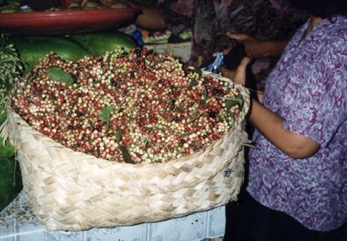
A tropical plant. It can probably grow up to 1000 m altitude in the tropics. In Indonesia it grows between 50-1,400 m above sea level. It can stand light frost. They can grow on a variety of soils. They are common and widely distributed in open places and secondary forest throughout the Philippines. It can tolerate salt. It suits the humid tropical lowlands. It suits hardiness zones 10-12. In XTBG Yunnan.
Also known as:
Amati, Anepu, Ariyaporiyan, Banshial buka, Bashial buka, Bignai, Bol-aborak, Bor-heloch, Bugnay, Buneh, Dieng-soh-silli, Herbert River cherry, Himalchari, Himalcheri, Huni, Karanda, Kantjer, Karawala keballa, Karikoomma, Kinbalin, Kunchur-kung, Kywe-pyisin, Malung renu, Nayikoote, Nolaiali, Noolitali, Pani heloch, Pohon buni, Salamander tree, Somkongasing, Sonkong esing, Wuni
Synonyms
- Antidesma dallachyanum Baillon
- Antidesma rumphii Tulasne
- Stilago bunius L.
- Antidesma collettii Craib.
- Antidesma thorelianum Gagnep
Edible Portion
- Fruit, Leaves, Spice
Where does Chinese laurel grow?
Found in: Andamans, Asia, Australia, Bangladesh, Bhutan, Brazil, Cambodia, China, Cuba, Hawaii, Himalayas, India, Indochina, Indonesia, Laos, Malaysia, Myanmar, Nepal, Northeastern India, Pacific, Papua New Guinea, PNG, Philippines, SE Asia, Sikkim, Singapore, Solomon Islands, South America, Sri Lanka, Thailand, Tibet, United States, Vietnam
Notes: There are about 100-170 Antidesma species.
Status: It is a cultivated food plant. The fruit are sold in markets. This in only a minor edible fruit of lowland tropical areas. It is important in Indonesia and occasional in Papua New Guinea. The fruit are especially eaten by children.
Growing Chinese laurel, Bignay, Currant Tree, Buni
Cultivation: It grows from seeds. These can be planted, but trees also grow naturally from seed. Trees can be produced by budding, grafting or from cuttings. Aerial layering can also be used. Spacing should be about 12 to 14 metres between trees. Some male trees need to be present for cross pollination. When female trees produce fruit without male trees, the seed from these fruit normally will not germinate.
Edible Uses: The fruit are eaten raw when ripe or cooked. They are acid so are often better as jam, jellies and wine. Because the fruit is high in pectin it makes good jams and jellies. The young leaves are eaten raw or steamed with rice. They are used as a spice or flavouring. CAUTION The bark is poisonous.
Production: Seedling trees fruit 4-5 years after planting. The fruiting season lasts a couple of months. In India plants flower and fruit April to August.
Nutrition Info
per 100g edible portion| Edible Part | Energy (kcal) | Protein (g) | Iron (mg) | Vitamin A (ug) | Vitamin c (mg) | Zinc (mg) | % Water |
|---|---|---|---|---|---|---|---|
| Fruit | 67 | 0.7 | 0.9 | 31 | 69 | - | 81.7 |
| Leaves | - | - | - | - | - | - |
Chinese laurel, Bignay, Currant Tree, Buni Photos

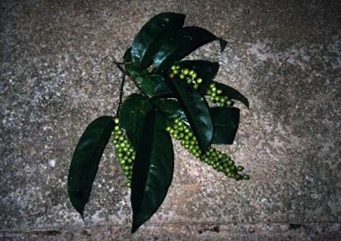
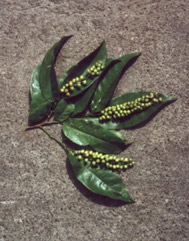
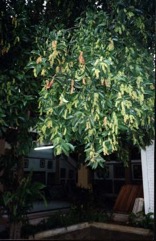
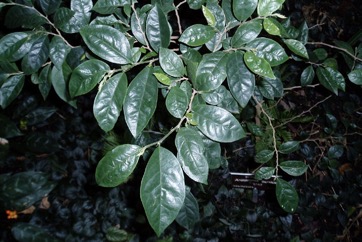
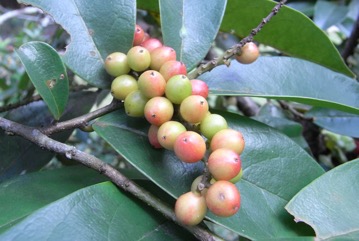
References
REFERENCES Antidesma bunius
Airy Shaw, 1972, Kew Bulletin 26(2) p 353
Alegado, A. M. & De Guzman, R. B., 2014, Indigenous food crops of the Aetas tribe in the Philippines and their traditional methods of food preparation. in Promotion of Underutilized Indigenous Food Resources for Food Security and Nutrition in Asia and Pacific. FAO. Bangkok p 160
Ambasta S.P. (Ed.), 2000, The Useful Plants of India. CSIR India. p 45
Anon , 1921, Philipp. Agric Rev. 14 p 243
Arora, R. K., 2014, Diversity in Underutilized Plant Species - An Asia-Pacific Perspective. Bioversity International. p 57
Ashton, M. S., et al 1997, A Field Guide to the Common Trees and Shrubs of Sri Lanka. WHT Publications Ltd. p 193
Bailey, F M., 1902, Rep British New Guinea p 3
Bajpai, O., et al, 2015, Tree species of the Himalayan Terai region of Uttar Pradesh, India: a checklist. Check List 11(4): 1718
BARC, 2016, State of Biodiversity for Food and Agriculture in Bangladesh. Bangladesh Agricultural Research Council.
Barcelo, R., 2015, Phytochemical Screening and Antioxidant Activity of Edible Wild Fruits in Benguet, Cordillera Administrative Region, Philippines. Electronic Journal of Biology, 2015, Vol.11(3): 80-89
Barwick, M., 2004, Tropical and Subtropical Trees. A Worldwide Encyclopedic Guide. Thames and Hudson p 28
Bircher, A. G. & Bircher, W. H., 2000, Encyclopedia of Fruit Trees and Edible Flowering Plants in Egypt and the Subtropics. AUC Press. p 34
Black, A A 1870, Treasures Botany 1:75
Bodner, C. C. and Gereau, R. E., 1988, A Contribution to Bontoc Ethnobotany. Economic Botany, 43(2): 307-369
Brown, W.H., 1920, Wild Food Plants of the Philippines. Bureau of Forestry Bulletin No. 21 Manila. p 80
Brown, 1951, Useful Plants of the Philippines p 296
1977, Buah Buahan, Lembaga Biologi Nasional p 26
Burkill, I H, 1935, A Dictionary of the Economic Products of the Malay Peninsula p 185
Carig, Elizabeth T., 2020, Guidebook on Native Trees within the Quirino Forest Landscape. Plaridel, Bulacan, St. Andrew Publishing House. p 39
Chakraborty, S. & Chaturbedi, H. P., 2014, Some Wild Edible Fruits of Tripura- A Survey. Indian Journal of Applied research. (4) 9
Cherikoff V. & Isaacs, J., The Bush Food Handbook. How to gather, grow, process and cook Australian Wild Foods. Ti Tree Press, Australia p 144, 198
Chua-Barcelo, R. T., 2014, Ethnobotanical survey of edible wild fruits in Benguet, Cordillera administrative region, the Philippines. Asian Pac. J. Trop. Biomed. 4(Suppl. 1):S525-S538
Cook, A A., 1975, Diseases of Tropical; and Subtropical fruits and nuts. Hafner
Cooper W & Cooper W T, 1994, Fruits of the Rain Forest. RD Press p 34
Cooper, W. and Cooper, W., 2004, Fruits of the Australian Tropical Rainforest. Nokomis Editions, Victoria, Australia. p 172
Corner, Wayside Trees of Malaya p 231
Coronel, R.E., 1982, Fruit Collections in the Philippines. IBPGR Newsletter p 6
Cribb, A.B. & J.W., 1976, Wild Food in Australia, Fontana. p 22
Cundall, P., (ed.), 2004, Gardening Australia: flora: the gardener's bible. ABC Books. p 161
Darley, J.J., 1993, Know and Enjoy Tropical Fruit. P & S Publishers. p 119
Delang, C. O., 2007, Ecological Succession of Usable Plants in an Eleven-Year Fallow Cycle in North Lao P.D.R., Ethnobotany Research and Applications. Vol. 5:331-350
Dobriyal, M. J. R. & Dobriyal, R., 2014, Non Wood Forest Produce an Option for Ethnic Food and Nutritional Security in India. Int. J. of Usuf. Mngt. 15(1):17-37
Elliot, W.R., & Jones, D.L., 1982, Encyclopedia of Australian Plants suitable for cultivation. Vol 2. Lothian. p 208
Facciola, S., 1998, Cornucopia 2: a Source Book of Edible Plants. Kampong Publications, p 240
Flora of China. www.eFloras.org
French, B., 1986, Food Plants of Papua New Guinea, Asia Pacific Science Foundation p 290
Hazarika, T. K., et al, 2012, Studies on wild fruits of Mizoram, India used as ethno-medicines. Genetic Resources and Crop Evolution. Published on line 03 February, 2012
Hedricks U.P. (ed) 1919, Sturtevant’s Edible Plants of the World. Dover p 60
Heyne, K., 1927, Nutt. Plant. Ned. Ind. p 915
Hibbert, M., 2002, The Aussie Plant Finder 2002, Florilegium. p 30
Hill, M. & Hallam, D., (eds), 1997, Na Hang Nature Reserve, Tat Ke Sector. Site description and conservation evaluation. Hanoi. p 77
Hooker, Flora of British India Vol V p 357
Hu, Shiu-ying, 2005, Food Plants of China. The Chinese University Press. p 509
INFOODS:FAO/INFOODS Databases
Jackes, B.R., 2001, Plants of the Tropics. Rainforest to Heath. An Identification Guide. James Cook University. p 51
Jeeva, S., 2009, Horticultural potential of wild edible fruits used by the Khasi tribes of Meghalaya. Journal or Horticulture and Forestry Vol. 1(9) pp. 182-192
Jones D, L, 1986, Ornamental Rainforest Plants in Australia, Reed Books, p 180, 340
Kalshoven, L.G.E., 1951, De Plagen van de Cultuur Gewassen in Indonesie. p 1026
Kiple, K.F. & Ornelas, K.C., (eds), 2000, The Cambridge World History of Food. CUP p 1732
Lazarides, M. & Hince, B., 1993, Handbook of Economic Plants of Australia, CSIRO. p 22
Lembaga Biologi Nasional, 1977, Buah-Buahan, Balai Pustaka, Jakarta. p 26
Leon, J. 1968, Fundamentos Botanicos de los Cultiuvos Tropicales. p 350
Llamas, K.A., 2003, Tropical Flowering Plants. Timber Press. p 187
Lorenzi, H., Bacher, L., Lacerda, M. & Sartori, S., 2006, Brazilian Fruits & Cultivated Exotics. Sao Paulo, Instituto Plantarum de Estuados da Flora Ltda. p 410
Macmillan, H.F. (Revised Barlow, H.S., et al) 1991, Tropical Planting and Gardening. Sixth edition. Malayan Nature Society. Kuala Lumpur. p 291
Maranon, J., 1935, Nutritive mineral value of Philippine food plants. Philipp. J Sci. 53:317-358.
Martin, F.W. & Ruberte, R.M., 1979, Edible Leaves of the Tropics. Antillian College Press, Mayaguez, Puerto Rico. p 55, 179, 191
Martin, F. W., et al, 1987, Perennial Edible Fruits of the Tropics. USDA Handbook 642 p 25
Monsalud, M.R., Tongacan, A.L., Lopez, F.R., & Lagrimas, M.Q., 1966, Edible Wild Plants in Philippine Forests. Philippine Journal of Science. p 465
Morton, J. F., 1987, Fruits of Warm Climates. Wipf & Stock Publishers p 210
Neal, C.M., 1965, In Gardens of Hawaii. Bishop Museum Press.
Nicholson, N & H., 1994, Australian Rainforest Plants 4, Terania Rainforest Publishing. NSW. p 9
Nurfadilah, S., et al, 2017, Species richness, conservation status, and potential uses of plants in Segara Anakan Area of Sempu Island, East Java, Indonesia. BIODIVERSITAS. Volume 18, Number 4
Ochse, J.J. et al, 1931, Vegetables of the Dutch East Indies. Asher reprint. p 262
Ochse,J.J., Dijkman,M.J., Soule, M.J.& Wehlburg,C., 1961, Tropical and Subtropical Agriculture. P 599
Pasha, M. K. & Uddin, S. B., 2019, Minor Edible Fruits of Bangladesh. Bangladesh J. Plant Taxon. 26(2): 299–313
Patiri, B. & Borah, A., 2007, Wild Edible Plants of Assam. Geethaki Publishers. p 124
Pegu, R., et al, 2013, Ethnobotanical study of Wild Edible Plants in Poba Reserved Forest, Assam, India. Research Journal of Agriculture and Forestry Sciences 1(3):1-10
Polinag, M. A., 2003, Food from the Wilderness. Department of Environment and Natural Resources. Laguna.
PROSEA (Plant Resources of South East Asia) handbook, Volume 2, 1991, Edible fruits and nut. p 78
PROSEA handbook Volume 13 Spices. p 274
Purseglove, J.W., 1968, Tropical Crops Dicotyledons, Longmans. p 139
Queensland Forest Service, 1991, Trees and Shrubs. Department of Primary Industries. p 62
Rajapaksha, U., 1998, Traditional Food Plants in Sri Lanka. HARTI, Sri Lanka. p 206
Ramakrishnan, T.S., & Sundaram, N.V., 1952, A new rust on Antidesma in India. Trans. Brit. Mycol. Soc. 35:26-28
Recher, P, 2001, Fruit Spirit Botanical Gardens Plant Index. www.nrg.com.au/~recher/ seedlist.html p 1
Rumf. 17, Herbarium Amboinense 3, 170, p 204.
Sarma, H., et al, 2010, Updated Estimates of Wild Edible and Threatened Plants of Assam: A Meta-analysis. International Journal of Botany 6(4): 414-423
Savita, et al, 2006, Studies on wild edible plants of ethnic people in east Sikkim. Asian J. of Bio Sci. (2006) Vol. 1 No. 2 : 117-125
Sawian, J. T., et al, 2007, Wild edible plants of Meghalaya, North-east India. Natural Product Radiance Vol. 6(5): p 413
Seidemann J., 2005, World Spice Plants. Economic Usage, Botany, Taxonomy. Springer. p 45
Singh, H.B., Arora R.K.,1978, Wild edible Plants of India. Indian Council of Agricultural Research, New Delhi. p17, 49
Sosef, M. S. M., Hong, L. T., & Prawirohatmodjo, S., (Eds.), 1998, Timber tree: Lesser-known timbers. Plant Resources of South-East Asia, 5(3), p 74
Sukarya, D. G., (Ed.) 2013, 3,500 Plant Species of the Botanic Gardens of Indonesia. LIPI p 128
Syst. veg. 1:826. 1824
Tanaka,T., 1976, Tanaka's Cyclopedia of Edible Plants of the World. Keigaku Publishing, Tokyo. p 50
Tate, D., 1999, Tropical Fruit. Archipelago Press. Singapore. p 24
Terra, G.J.A., 1973, Tropical Vegetables. Communication 54e Royal Tropical Institute, Amsterdam, p 25
Townsend, K., 1994, Across the Top. Gardening with Australian Plants in the tropics. Society for Growing Australian Plants, Townsville Branch Inc. p 83
USDA, ARS, National Genetic Resources Program. Germplasm Resources Information Network - (GRIN). [Online Database] National Germplasm Resources Laboratory, Beltsville, Maryland. Available: www.ars-grin.gov/cgi-bin/npgs/html/econ.pl (10 April 2000)
Uphof, J.C.Th.,1968, Dictionary of Economic Plants 591pp Cramer p
Walter, A. & Sam C., 2002, Fruits of Oceania. ACIAR Monograph No. 85. Canberra. p 278
1948 Wealth of India p 84
Wight, R., 1963, Icones Plantarum Indiae Orientalis Vol 3 Pl 819.
Wild edible plants of Himachal Pradesh
Williams, K.A.W., 1999, Native Plants of Queensland Volume 4. Keith A.W. Williams North Ipswich, Australia. p 54
www.worldagroforestrycentre.org/treedb/
Flora of Thailand. www.nationalherbarium.nl/thaueuph/
World Checklist of Useful Plant Species 2020. Royal Botanic Gardens, Kew
www.pngplants.org